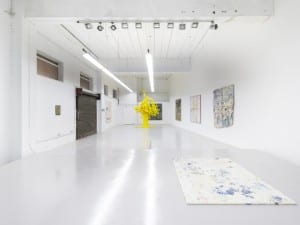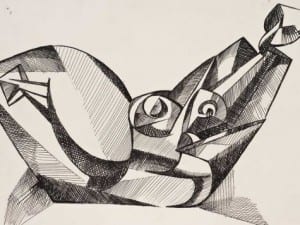“I think there is a world market for maybe five computers” said Thomas Watson, chairman of IBM, in 1943, proving again that in the realm of technology it is very dangerous to make any prediction at all. So although the Barbican’s Digital Revolution is an exhibition of 30-ish years of digital art, computers, websites, CGI, music videos and games rather than a manifesto, there is still some slight hubris-in-the-making at work in its putting games made in the 1990s alongside examples of contemporary technology and artwork. You feel the future looking over your shoulder throughout, and the future has a tendency to assume we were all quaint. So the Barbican is to be admired and not envied: it has curated a show that will end up being discovered as what 2014 thought of itself.
Your feelings about the opening room – part elephants’ graveyard, part hallowed sarcophagus of operating systems and games – will probably depend on your age. With games like Doom, PaRappa the Rapper, Sonic, Space Invaders and the first Tomb Raider it could feel like remembering bands you used to listen to. This room is wonderful, always the busiest, and sets the tone for the whole. This is not an art exhibition, it is an exhibition of the development of the uses of the computer. As a result, the look behind how Inception and Gravity were made (“in this shot everything but Sandra’s face is computer animated”) seem to outstrip some of the “real” art on show now that we expect art to be more than aesthetic.
Two strains of digital art appear to have emerged: that which uses technology as more of a subject and that which uses it as a medium. The first set is perhaps a visual arts equivalent of Neo-Futurism in architecture – the movement that gave us Norman Foster, Zaha Hadid, Buckminster Fuller and Renzo Piano – that seeks to use technology to look new. As such, it bravely runs the risk of rapidly looking “achronistic”, as Jack Orlik points out in Apollo or as weirdly misguided as Marinetti now looks alongside Picasso and Braque. As past art movements and Star Trek tell us, the future seldom ages well.
This is, however, not to say we shouldn’t try, and the most successful applications of digital technology to art may make use of new advances, but at their core is an understanding of the reason for technology: to make human lives easier and richer by improving access to knowledge, skills, or each other. This was the morality behind Tim Berners-Lee’s first website (on show in room 1), and from it comes the idea of human interconnectedness, using technology, as a mode of human expression or thought.
Whether by chance or not, two of the pieces in this exhibition which manage to accomplish this are in the Google-sponsored room DevArt: Karsten Schmidt’s Co(de)factory, 2014 and Zach Lieberman Play the World, 2014. Taking on Joseph Beuys’ assertion that “everyone is an artist”, Schimdt has coded an online design tool where anybody can “modify an object in countless ways through a web browser”. Everyday the Barbican chooses one such modification to be 3D printed and displayed in the gallery – an ingenious literalisation of Beuys’ idea carried off much more successfully and openly than it usually is. Normally there is an obvious presence of The Artist still rising above the rest of the artists, but Schmidt has managed to disappear totally and the artist has become truly a facilitator rather than a lead maker of art. Lieberman has hooked up an electric keyboard to a radio receiver, and when a key is pressed the code searches for that note sounding on any radio station around the world at that moment – displaying the geographical position of the transmitter on a map and playing the station in question. There is a sense that this piece, inside the Barbican, is just one part of a global community, speaking a variety of languages playing a variety of music, bought together by sharing with someone, somewhere, a certain note.
In an underground room Usman Haque and Dot Samen from Umbrellium bring us Assemblance (2014) – an immersive piece made with smoke and lasers that allows its participants to control a kind of light field, either uniting or distancing themselves from others. Magic barriers and muslin drapes belonging in four-poster beds are made with a sweep of your arm, like you are a sorcerer, and you end up trying to grab the end of a fluttering curtain before forgetting it is just a mirage, or playing with people to try to make something solid with your trails of light.
Because it is the emphasis on connection between humans, which art has always sought to accomplish on some level, that makes for the strongest work here. Also worth mentioning are James George and Jonathan Minard’s documentary Clouds (2013), where questions and topics are linked in a web-like manner through the specialists that speak on them, and James Bridle’s Dronestagram (2012–ongoing) which shows pictures taken by US army drones of their targets to concentrate us on the dark side of technological human connection: surveillance. At a time when technology is no longer seen as an unproblematic extension of evolution, and we start to notice that it can be used for good and ill like nuclear power before it, this kind of retrospective is well worth going to. Although computers can make powerful illusions, guide bombs onto shepherds or become idols themselves, the unhierarchical model of society they give and enable seems like a source of hope and good art, a judgement for which the future will pat me condescendingly on the head.
Digital Revolution: An immersive exhibition of art, design, film, music and videogames, until 14 September, Barbican Centre, London.
Jack Castle
Credits
1. ISAM, 2011. Amon Tobin. Image courtesy of Calder Wilson.





